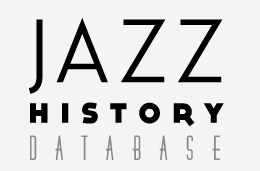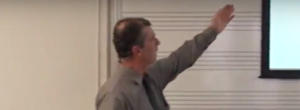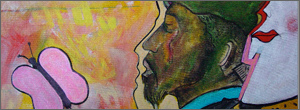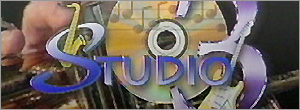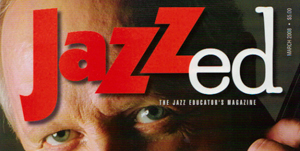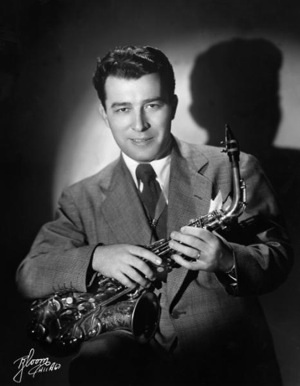
By Chet Williamson:
Kid Boots and the Milford years
He was born Enrico (Henry) William Mussulli. He was known as “The Music Man from Milford,” “Mr. Jazz,” and the “Little Big Man,” but people everywhere more often affectionately called him by his nickname, “Boots” – he was listed that way in the phonebook.
He was described in a 1965 Worcester Telegram & Gazette column called “They Made the Headlines,” as one of the top sax players of his day, who joined Mal Hallett’s band as a teenager and later featured with Stan Kenton, Gene Krupa and other top bands. “In Hollywood, he was featured in dozens of movies; one of these was a Talk About A Lady.”
Mussulli was also a teacher who led his own quartet, a youth orchestra, appeared on numerous albums, on radio and television, and operated the nationally known Crystal Room in Milford.
As a saxophonist, he was also a modernist who heard and played bebop long before it became fashionable. He was known as a brilliant musician who once said that music is like religion, it doesn’t stop. Throughout his young life, Mussulli challenged himself, his colleagues, and students to keep striving for excellence. And, although he has been dead for nearly 35 years, his influence, his legacy and lessons are like that religion – it hasn’t stopped.
He was born in Milford, MA on November 18, 1915. The Italian spelling of the family name is MASULLI, which probably explains why Boots’ name is spelled incorrectly in the town hall directory, where he is listed as “Ricco Masula.”
His parents were Pasquale and Pierina (Celozzi) from Casalvecchio di Puglia, Province of Foggia, Italy. Boots was born at the family homestead at 6-8 Pond Street in Milford. He was the eighth born of eleven children.
According to Deacon Patrick Mussulli (Sacred Heart of Jesus Parrish of Milford and Boots’ nephew), the house is an apartment building first used as a boarding house for Italian immigrants, skilled stonecutters, brought to the town to work at Dodds Quarry on Cedar Street. The quarry was then rich in pink granite made famous by the stone pillars at Grand Central Station.
“It’s now a shopping mall,” says Deacon Mussulli in a recent interview. “I remember all the men would meet early in the morning at Supple Square and march down Main Street to work at the quarry. Boots’ father was one of those men.”
The family homestead is not far from the Charles River (the same dirty water that runs into Boston). Mussulli acquired his moniker from trouncing around in its mud and wearing boots, rain or shine, inside or out-of-doors.
Boots received his first instrument when he was nine years-old. There is still somewhat of a discrepancy as to whether it was a clarinet or saxophone. In a recent interview with his 100 year-old brother, Anthony (who lives with his son, Deacon Patrick), the centenarian declared emphatically that it was the saxophone. Deacon Patrick says, “I think he really started on the clarinet.”
What both gentlemen agree upon is that Boots spent time in the woodshed. “Oh, yes,” Tony says. “Boots practiced all the time.”
Boots himself once told writer Olive E. Guiney that he used to practice six hours a day. “My mother, doing mountains of ironing, used to ask me to stop at least long enough to eat a sandwich, but it seemed I couldn’t get enough of that sax,” he said.
Mussulli put his first band together – Kid Boots and his Ramblers – when he was 10. Boyhood friend Frank Tamagni remembers Mussulli from those early days.
“He had terrific ears,” Tamagni said in a 1988 T&G interview. “I was coming up the stairs one time to his room and even before he could see me he’d yell, ‘Hey Frank!” (The late Tamagni was a tenor saxophonist/father of drummer Bob Tamagni.)
Mussulli was virtually self-taught. “He studied with Julio Zorzi, a local sax player and teacher. Boots went through one method book with him and that was the extent of his music education,” said Tamagni.
Writer Guiney added: “He had been taking lessons from his music teacher, Julio Zorzi, for six months when the mentor had Boots standing on a chair so he could be seen in front of the band taking solos on ‘12th Street Rag,’ ‘Saxophobia,’ and ‘Doll Dance,’ instrumental hits of the 1920s.”
Boots formed his first orchestra at 14, and started to study arranging with local pianist Tony Gareri. “Tony was my idol,” Boots told Guiney. “When I formed my trio later on, he played piano for me.”
Mussulli was educated in public schools. According to Guiney, Boots was spellbound with arranging and spent hours pouring over music and because of that, “his regular school took a beating.” Still, Mussulli is a graduate of Milford High School.
“The teachers gave me a mark for being there,” he told Guiney, “but I think I must have gotten the worst grades in the history of Milford High School. The only course I got an ‘A’ in was music.”
Graduation marked the end of Mussulli’s formal schooling, although there are reports that he took courses at the Schillinger House.
Over the next 40 years, until his untimely death in 1967, Mussulli was in demand. He went on to become one of the finest jazz alto saxophonists of the 20th century, often compared to Charlie Parker. In the late 1940s, the two were often voted 1-2 in Downbeat Magazine’s musician’s poll.
His first break came as an 18 year-old fresh out of high school. His reputation among local and regional musicians was already spreading when he was hired by Boston-based orchestra leader Mal Hallett.
According to Milford writer Ted Rose, the band was touring New England, and had played a local date in the Blackstone Valley neighborhood. After inviting the young musician that he had heard about to sit in, Hallett was impressed. But when the popular band leader was informed that Mussulli could also orchestrate, he “quickly hired the youngster to become a full-time member of the touring band.”
According to jazz historian George T. Simon, Hallett was respected among musicians. “He gave them opportunities to play good music,” Simon wrote, “even before [Benny] Goodman made it fashionable.”
A partial list of those who played among the Hallett ranks include Jack Teagarden, Gene Krupa, Frankie Carle, Turk Murphy, Toots Mondello, and in addition to Mussulli, a few local players as well, including Don Fagerquist and Emil Haddad.
Mussulli worked with Hallett throughout the 1930s. Before the decade was out however he had married his high school sweetheart Rose Cutropia and in 1938 the couple saw the arrival of what would be the first of four daughters.
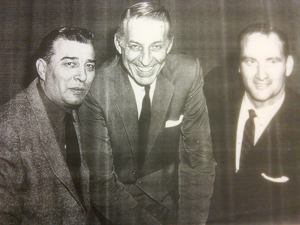
Settling back in town, Mussulli put a trio together with pianist Tony Gerari and drummer Bob Varney. He also worked with the Chick Eddy Orchestra. Chick Eddy was actually saxophonist Michael Ciccetti born in Milford in 1925 – not to be confused with the Hartford-based Chick Ciccetti Orchestra.
Worcester trumpeter Tony D’Angelo (guitarists Joe and Jimmy’s uncle) was 16 when he was enlisted for the band. “I went to see the band and when they took a break I started checking out their music. Boots noticed that I was interested and asked me if I was a musician. I said yes and he says, ‘Do you think you can play this stuff?’ I said, I don’t know, but I’d like to try.”
With that, Mussulli invited the young D’Angelo to a rehearsal and to the youngster’s surprise, he made the gig. Now 86, D’Angelo in a recent interview said that the Chick Eddy Band was a nine-piece ensemble that featured Mussulli, who doubled on all reeds and along with pianist Tony Gerari supplied the group its arrangements.
“We played the latest tunes of the day,” D’Angelo says. “We had a good name. The band consisted of five saxes, two trumpets, no bone, drums and piano. That was it.”
The members of the band were basically the Milford musicians and friends who had grown up with Mussulli. In addition to Mussulli, Ciccetti, Gareri, Varney, D’Angelo, the group was completed by saxophonists Frank Tamagni, Red Lennox and Paul Shuba, along with trumpeter Ziggy (Minichiello) Kelly.
“Ziggy was so great,” D’Angelo said. “We’d go on a job and he’d say, ‘What’s my first note?’ Most times he could play the whole chart without looking.
As a 16 year-old impressionable musician, D’Angelo says he recalls driving to Milford at least three times a week for rehearsals and gigs.
“We’d rehearse at Boots’ studio above the Ideal Lunch on the second floor. It was so small that the band would fill the room.”
Writer Guiney would later described it. “The Studio is a little box of a place, Room 18 at 189 Main St., in Milford,” she wrote. “It doesn’t even have his name on the door. It has a desk and three chairs, and the walls are papered with pictures of jazz greats Boots has traveled and played with.”
D’Angelo remembers the Chick Eddy working often. Highlights include the Roseland Ballroom in Trumball Square in Worcester. He says he was with the band for a couple of years beginning in 1941. With the advent of WWII, the band met its demise.
“The band broke up because all the guys went in the service,” D’Angelo said. Others went with Teddy Powell, including Boots and Ziggy Kelly.”
In recalling Mussulli’s playing at that time, D’Angelo said: “I never realized how great he was ‘til he played with Toshiko Akyoshi [early ‘50s after the war]. “When I first heard Charlie Parker I swear he took what Boots did and took it to a new level.”
It was with Powell that Mussulli began to be recognized nationally. He replaced the great clarinetist Irving Fazola.
In a 1988 interview, Frank Tamagni recalls the rather humorous circumstances of his hiring:
“Boots was recommended to Powell as a guy who might replace Fazola. So Teddy calls his house one morning at 10 o’clock. His wife answers and says, [Boots] is working. ‘Working?’ Powell asks, is this the number of Boots Mussulli the same guy that plays the saxophone?’”
“The Music Man from Milford” not only worked with his trio and Chick Eddy, he also had a day job. He worked at the Draper Corp., a foundry in nearby Hopedale.
“Boots hated the place,” Mrs. Mussulli said in the same 1988 interview. “I think he worked there all of one month. He couldn’t wait to get out of there, so when the Powell offer came up, he jumped at it.”
At its height, the Teddy Powell Orchestra was one of the more popular bands in all of jazz. The group recorded extensively and in addition to Fazola, such musicians as saxophonist Charlie Ventura and trumpeter Pete Candoli were members.
In 1944, Mussulli joined the Stan Kenton orchestra, a new experimental band from the West Coast that Mussulli found the most exciting of the day because, as he put it, “ … his arrangements seemed to open up the chords, made them sound fuller, bigger, richer, and more colorful than jazz ever sounded before. After I heard them I couldn’t wait to join.”
The Milford Music Man preceded some of the finest alto players ever to play the instrument: Art Pepper, Lee Konitz, Lennie Neihaus, Bud Shank, and Charlie Mariano all sat in the alto chair in Kenton’s band.
The late Leo Curran, also from Milford, who had begun as the Kenton band boy and stayed long enough to become road manager, remembers those days. In a 1988 interview, he said, “Mussulli played alto in the band and sat next to Vido Musso. They were like brothers. They roomed and hung out together on the road. They used to call those guys the Mafia.”
Mussulli’s first stint with the band was until 1947. He would rejoin the group for a second tour action from 1952 to 1954. In between, he would also work with Vido Musso and Gene Krupa in 1948 and Charlie Ventura in 1949, the same year he opened a jazz venue called “The Crystal Room” in the Sons of Italy Hall, 45 Sumner Street in his hometown of Milford (now THAT Corp.).
In 1955, Mussulli was off the national circuit choosing instead to work and record regionally with Serge Chaloff, Ray Santisi, and Toshiko Akiyoshi. In 1956, he played lead alto in the Herb Pomeroy Big Band.
Writer Ted Rose recalls Mussulli playing with Pomeroy’s orchestra at New York’s Birdland in 1956: “Boots so impressed Benny Goodman with his playing that the legendary leader tried to get him to join his group, but Boots declined, explaining that he had returned home to be near his wife and four daughters.”
“Not one to shun responsibilities,” says Leo Curran, an old friend from Milford. “He could have said ‘later’ for this small-town atmosphere and take off for the big city and play the jazz he loved so well.”
But he didn’t. He stayed and left a legacy that is alive and well today. Fellow musician Emil Haddad said, “He was the magnet in this area; everybody took to him.”
By 1957, Mussulli quit that national scene altogether. The road, bandleader Kenton once said, is a young man’s career. “Older men can’t swing it.” As Mrs. Mussulli put it in 1988, “It was fun, we went to California with the band but living on trains and buses got to be too much.” So the Mussullis came home to Milford and Boots began teaching. He opened a studio in an office building downtown, “Room 18” at 189 Main St.
A partial list of musicians who had studied with him includes: drummers Frankie Capp and Bob Tamagni, pianist Dave McKenna, trumpeters Don Fagerquist, Don Ellis, Jerry Seeco, Lou Borelli, and John D’earth, saxophonists Jackie Stevens, Ken Sawyer, Tom Herbert, and Ron Julian, Bill Garcia, Mike Crowley, Wayne Kuczinski, Joe Andrade, and Richie Cammuso; trombonists Tony Lada and Gary Valente; and many others who continue to play and teach around Central New England.
“He was like an uncle to me,” said McKenna in 1988. “Words can’t express my feelings for the man. He was a teacher to all of us.”
In an interview with Whitney Balliett in the New Yorker, McKenna (born May 30, 1930) said. “When I was 16, I played with Boots Mussulli around Milford, which was just over the border from us in Massachusetts. Milford was eighty percent Italian and eighty percent musicians. There were never any bass players, so I had to finagle around a lot with my left hand to make it sound full, which is why I have that guitar effect – that strumming thing in my left hand now.”
In the early ‘50s, McKenna was drafted into the Army. “When I got home, Boots Mussulli said I sounded the same even though I hardly touched the piano since I’d been away – which is strange, because I’ve never had that many chops. Once in a while, I’d go back to Milford just to eat.”
Mussulli’s reputation as an educator was well-known – even nationally. Saxophonist Ken Sawyer, a teacher himself, recalls, “I remember one time I saw Dizzy Gillespie in concert, his alto player at the time was a guy by the name of Leo Wright. The next day who should be waiting in line to take a lesson with Boots but Wright.”
According to Deacon Patrick, the family homestead was first purchased by Boot’s maternal grandmother Annantonia Flacco.
“When she died my uncle Boots bought the house to settle the estate,” he said. “Uncle Boots lived in 6 Pond in the first floor apartment, next to the driveway. We lived at 8 Pond Street. I lived on Pond Street until I was 10 years old. We lived upstairs. Uncle Boots lived downstairs in the apartment.”
Throughout his life Mussulli continued his regime of regular practicing, as Deacon attests: “It was true. You’d hear music being played all day. His apartment was really small. There was like a little room that he would sit in playing and he would give his music lessons in there.
“When we were small we’d go out in the yard to play which was right under the window and I remember my mother saying don’t make any noise. Uncle Boots is practicing. I’d be with all my cousins. We’d say, ‘Play a polka.’ He used to get the biggest kick out of us dancing. Uncle Boots always played.”
In addition to establishing his teaching, Mussulli organized a new quartet with pianist Danny Camacho, bassist Joe Holovnia, and drummer Arthur Andrade.
In describing the band to writer Guiney, while a member of the group, Holovnia said, “With Boots fronting the quartet, everything is beautifully controlled. He’s the spark that keeps things bubbling. We worked pretty steadily with him maybe 10 years.” The group was also captured live by WGBH TV on the show “Jazz with Father O'Connor.”
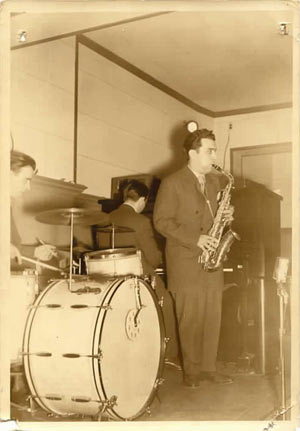
Pianist Andrade’s kid brother Joe studied with Boots back in the day.
“I was his last student on Thursday night,” he said. “Boots didn’t drive. I used to bring him home after my lesson. I played alto. Boots was a very good teacher. We worked on a lot of legitimate stuff. Every lesson he would write out one of the old riffs for me. As a matter of fact, I’ve got a stack of handwritten riffs from him. He would just write them off the top of his head … ‘Groovin’ High,’ and all of that stuff.”
Throughout the ‘50s and ‘60s, Mussulli continued to work in Boston, taking dates with friends and with his own group.
“I used to get a big kick out of going to Milford and hearing Boots there,” Sawyer said. “He was appreciated, but when I went to Boston, he was a star! People came from miles around to catch this fantastic alto saxophone player. That’s when I realized what a giant he really was.”
Small town U.S.A. could have swallowed a lesser man. Mussulli often said that if he couldn’t tour the world, he would bring the world to Milford. His jazz concerts at the Crystal Ballroom in the Sons of Italy featured Stan Kenton, Duke Ellington, Count Basie, Harry James, Maynard Ferguson, Kai Winding, J.J. Johnson, and Charlie Parker, among many others.
Guiney once wrote: “Sometimes Boots reminisces about Charlie Parker, the legendary saxophonist whose mind and fingers worked with such incredible speed, that he brought jazz improvisation to a new peak. Boots showed us a clipping he had saved about Parker.
After reading it, we knew why it meant so much to Boots: “It’s as if you had two roads,” the article began, “both going in the same direction. One of them is straight, with no scenery around it, and the other twists and turns and has a lot of beautiful trees on all sides. Charlie Parker takes you along that second road, often at such speed that at first you may be too dazed to see the view clearly.”
Mussulli once told Leonard Feather his list of favorite alto saxophonists and indicated how his style was influenced by the advent of Bebop: Johnny Hodges, Jimmy Dorsey, Charlie Parker, Lee Konitz and Charlie Mariano.
“Boots was very friendly with Charlie Parker,” Mussulli student Richie Cammuso said. “When Parker used to play at the Crystal Room he used to stay at Boots’ house. I went to those shows. I was a teenager then. Charlie Parker died in 1954. It was interesting how many people Boots knew and used to have at the Crystal Room in Milford.”
“He was in charge of renting out the hall,” Deacon Mussulli said of his uncle Boots. “He didn’t own the building but he would rent it out for different functions. Boots’ wife was an excellent cook. When he ran the Crystal Room like a night club he would send word down to his wife. ‘Honey cook up a meal because so and so is coming over.’ Two-three o’clock in the morning she’d cook up a meal.”
“Sometimes he made some money, sometimes he’d lose his shirt,” said Sawyer, who was a DJ at the time for WMRC in Milford and would also emcee shows. “But the love of jazz kept him doing it. Their series died with him, but as musician, teacher and producer, Boots put Milford on the jazz map.”
Besides the giants, Mussulli would showcase some of the young talent developing under his wing. One such student was Jackie Stevens, who began studying with Mussulli when he was 8.
“He was a jazz teacher,” said Stevens. “He had me playing with his band when I was 15, one time opposite Dizzy at the Crystal Room.”
Stevens, who received a full scholarship to Berklee with Mussulli’s help, used to bring fellow students to play.
In 1988 Stevens said, “I brought in Chick Corea when he was 18, and Hal Galper who is now with Phil Woods. The Japanese pianist Toshiko Akioshi was at Berklee at the time and Boots acted as her legal guardian.” In a recent review of Toshiko’s album on ITunes, Her Trio, Her Quartet an unknown writer states: “She gallops through ‘I Remember April,’ with Mussilli sounding very modern and not like a typical Charlie Parker clone in that era.’”
Mussulli recorded often, including his famous sessions produced by Stan Kenton. For a complete discography of his recording output, see his profile at Discogs.
In the liner notes to Mussulli’s 1954 Capitol release Little Big Man, Kenton said, “Boots Mussulli represents maturity in many respects because he feels an obligation, not only to himself but to others. His career has been one of studying to better himself and teaching to gain for others. His approach is quite sober with seriousness. Many musicians have been inspired because of his guidance and advice. His devotion to his family is equal to that of his music. Conscientious, dependable and greatly talented, Mussulli is one of the pillars of security in jazz.”
The Youth Orchestra
As far back as his touring days with Kenton, Mussulli had in mind the idea of organizing a youth band. To celebrate his 40th year in music, he announced plans for just such a project. Mussulli called it his “Great Adventure.”
According to Milford Daily News writer Linda Lowinski the process started in November of 1964. Mussulli began seeking youngsters for auditions. “He and Leo Curran of Milford, former road manager of the Kenton band, had talked about forming an 18-piece unity comprised of youngsters not older than 18.”
Mussulli began taking out ads in all the local papers to investigate local interest. To his surprise, he was swamped with inquiries. He got more than 700 calls. What resulted was an enormous big band consisting of 55-60 musicians who ranged in ages from 11 to 19. They came from as far away as Providence and some 17 neighboring towns.
“He sprang his musical ‘Frankenstein’ on the public at an Easter Sunday concert in 1965,” Lowinski wrote, “but there was nothing monstrous about the orchestra’s debut in the St. Mary’s Central Catholic High School auditorium that night. Overwhelmed with emotion and hardly believing what they had just seen and heard, an audience of 1,000 gave the orchestra a three-minute standing ovation at the conclusion of the test flight.”
“Acclaimed for its professionalism in playing in big band music, the orchestra recorded an album and appeared on television and radio while presenting an average of seven concerts a year,” Milford writer Ted Rose reported.
At 50, Mussulli was appointed a full-time member of the teaching staff in the Milford public school system by the School Committee. He was also a part-time music instructor at Nipmuc Regional High School in Mendon and the Upton Memorial School.
“I just want to pass on my knowledge to the youngsters,” Mussulli told writer Rose. “They hold the future of music. If I can help some youngster or anyone, for that matter, I’m happy.”
Lowinski wrote that the orchestra’s “biggest break was when Ernest Santosuosso, a Boston Globe music critic, heard it perform in Franklin, MA. Santosuosso couldn’t get over the powerful, exciting, professional band sound to the youngsters. Through his efforts the orchestra was engaged to perform at the Boston Globe Jazz Festival at Boston’s War Memorial Auditorium in January of 1967.”
Rose reported that the concert was a major success and that, “Mussulli and the youngsters received rave notices from music critics.” On the strength of the Boston Globe performance, the orchestra was then invited to the prestigious Newport Jazz Festival. That year, the Young Orchestra shared the bill with Duke Ellington, Sarah Vaughn, and Dave Brubeck, appearing on the afternoon of the Sunday, July 3rd program opposite the Don Ellis Orchestra.
Rose reported that the late bandleader and trumpeter Ellis, said that his first big band experience came rehearsing with Boots’ old orchestra in Milford while he was a student at Boston University.
Lowinski noted that George Wein, the festival’s producer introduced Mussulli as a former alto saxophonist with the Stan Kenton band. She went on to describe Mussulli at the downbeat: “ … a short, chunky man with graying temples and a poker face strolled on stage to conduct the orchestra. He was greeted with a smattering of polite applause.
“Hunching forward slightly, Mussulli pointed a fatherly finger toward the middle section of the band and began tapping his left foot rapidly to set a swinging rhythm pattern. ‘One, two, three, four,’ he chanted … And then it came – a rich, polished, powerful band sound that streamed through the strategically-placed amplifying system and rolled across the field with an electrical excitement that soon made the audience forget that these were kids playing the music of another generation.
“And 35 minutes later when the orchestra completed its streamlined performace with a big, rousing finish to Neil Heft’s ‘Splanky,’ the press section was on its feet leading the audience in enthusiastic applause.”
Lowinski reported that Wein was thrilled by the performance, telling the “hushed” audience that, “This is the greatest young band in the country. When I hear and see these kids, all I can think of is that if every high school in every town had a band like this, we wouldn’t have to worry about the future of jazz.”
Lowinski said that Ellis also commented on their show stating, “These kids are tremendous. Boots has something happening in Milford that the whole country should know about. How come I haven’t heard of them on the West Coast?”
A few short months after the 60-member youth orchestra was a surprise hit at Newport, Mussulli was dead. The “Music Man from Milford” died September 23, 1967 at the Pondville Hospital in Norfolk, MA. He was 51. He died while making plans to reorganize the Youth Orchestra of Milford for the upcoming 1967-68 concert season.
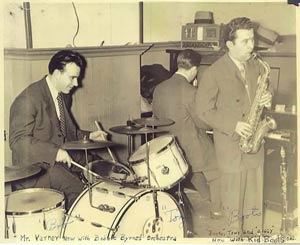
"He had cancer," said pianist Danny Camacho. "A year or two before he died, he was going to the hospital, a cancer center in Walpole. They found near the nape of his neck a growth there and gradually found out it had grown down his neck under his jaw and down his throat. It came all of a sudden. At first, he was told they got it all out. Same old familiar story. And for awhile he was feeling pretty good. Then all of a sudden, bingo! He was gone."
Milford writer Rose said, "Two Worcester musicians, who played with Boots over the years on local dates, drummer Ed Shamgochian, and trumpeter Emil Haddad, both were shocked to learn of the man's death.
"Boots was one of the greats," said Shamgochian, "Let's face it. He was the boy around here for music. Everyone knew Boots. He was a true virtuoso."
At the time of the announcement, Rose contacted Haddad who was leaving to play at a date at the Meadows in Framingham. "[He] was close to tears when told Boots was dead."
"Oh, man, I was just down to visit him," Haddad said. "He was one of the finest musicians ever. He adapted to the different styles over the years. He was a great arranger. A great composer. Everyone loved Boots."
Primary Sources
Birth Certificate for Ricco Masula [sic], 18 Nov. 1915, Massachusetts Registry of Vital Records & Statistics. The name "Ricco Masula" is given on the certificate, where his actual full name is "Enrico (William) Mussulli".
Guiney, Olive E. "Meet Milford's Mr. Jazz." Worcester Sunday Telegram 26 Jan. 1964, pp. 3-4. Print.
Interviews
DePasquale, Mauro. Interview with Joe Holovnia, 25 Feb. 2001. Video.
Falco, Richard. Interview with Ken Sawyer. Audio.
Williamson, Chet. Interview with Ken Sawyer. Audio.
Secondary Sources
Ameden, Danielle. "Local players kept vibrant Milford jazz scene jumping 50 years ago." MetroWest Daily News 25 Oct. 2008: Web. Last accessed 21 May 2012. Available at <http://www.metrowestdailynews.com/news/x1395943515/Local-players-kept-vibrant-Milford-jazz-scene-jumping-50-years-ago>.
"'Boots' Established The Pathway To The Future Of Jazz Education." Jazz Worcester Society: Print.
"Full-Time Position Lacks Title, Salary." Worcester Evening Gazette 16 June 1967: Print.
Lee, James. "Mussulli and His Quartet To Record for Capitol Monday." Worcester Evening Gazette 10 June 1954, p. 36: Print.
Mielinksi, Mary Anne. "Milford Mourns 'Boots' Mussulli." Worcester Telegram 25 Sep. 1967: Print.
Morin, Raymond. "Milford's Mussulli in New Career." Worcester Telegram 18 Dec. 1966: Print.
Phillips. "They Made the Headlines!" Feb. 1965: Print.
Tubert, Jack. "Milford Youth Band a Hit at Newport." Worcester Daily Telegram 4 July 1967, p. 10: Print.
Williamson, Chet. "Boots and the Fox." Jazzsphere. Web. Last accessed 21 May 2012. Available at <http://jazzhistorydatabase.com/blog-chet/?p=27>.
Williamson, Chet. "Boots Mussulli: The Worcester Jazz Society will honor 'The Music Man from Milford'." The Evening Gazette and Worcester Telegram 4-5 Feb. 1988: pp. 7, 9. Print.
Further Reading
"Bob Tamangi, Professor." Berklee College of Music. Web. Last accessed 21 May 2012. Available at <http://www.berklee.edu/faculty/detail/bob-tamagni>.
"Boots Mussulli Discography". Discogs. Last accessed 21 May 2012. Available at <http://www.discogs.com/artist/Boots+Mussulli>.
"Charlie Ventura." Wikipedia. Web. Last accessed 21 May 2012. Available at <http://en.wikipedia.org/wiki/Charlie_Ventura>.
"Gene Krupa." Wikipedia. Web. Last accessed 21 May 2012. Available at <http://en.wikipedia.org/wiki/Gene_Krupa>.
Haim, Albert. "Even More About Mal Hallett." Bixography Forum. Web. Last accessed 21 May 2012. Available at <http://www.network54.com/Forum/27140/message/1236392864/Even+More+About+Mal+Hallett>.
"Herb Pomeroy." Wikipedia. Web. Last accessed 21 May 2012. Available at <http://en.wikipedia.org/wiki/Herb_Pomeroy>.
Malloy, Daniel. "Howitzer." Sheltered From the Wicked World: Stories and Pictures from Hopedale's Past. Web. Last accessed 21 May 2012. Available at <http://www.hope1842.com/howitzer.html>.
Popa, Christopher. "Mall Hallett: 'An Earful of Music'." Big Band Library. Web. Last accessed 21 May 2012. Available at <http://www.bigbandlibrary.com/malhallett.html>.
"Serge Chaloff." Wikipedia. Web. Last accessed 21 May 2012. Available at <http://en.wikipedia.org/wiki/Serge_Chaloff>.
"Toshiko Akiyoshi." Wikipedia. Web. Last accessed 21 May 2012. Available at <http://en.wikipedia.org/wiki/Toshiko_Akiyoshi>.
"Vido Musso." Wikipedia. Web. Last accessed 21 May 2012. Available at <http://en.wikipedia.org/wiki/Vido_Musso>.
Wynn, Ron. "Irving Fazola." AllMusic. Web. Last accessed 21 May 2012. Available at <http://www.allmusic.com/artist/irving-fazola-p8514>.
Yanow, Scott. "Teddy Powell." AllMusic. Web. Last accessed 21 May 2012. Available at <http://www.allmusic.com/artist/teddy-powell-p175070/biography>.
